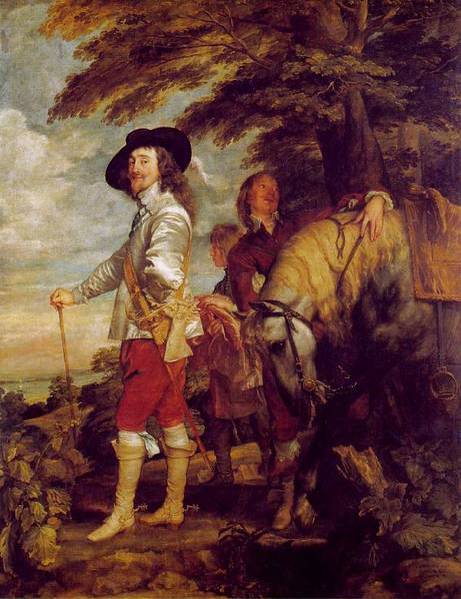 |
| Le Roi à la Chasse, 1635, oil on canvas, 272 x 212 cm, Louvre |
The king turns his head toward the viewer, his body facing the wide landscape which he has been surveying, looking out over the sea, the Isle of Wight in the distance. He looks relaxed and good-humoured, having dismounted to take a healthy stroll in the fresh air of the English countryside, seemingly oblivious to the presence of his two grooms.
He is dressed with casual elegance in a white satin jacket and a carefully positioned cavaliers broad-brimmed hat framing his face, which would otherwise be lost in the sky behind. One hand nonchalantly holds one long leather kid glove within the other while his right hand is outstretched toward the landscape over which he holds dominion, proudly grasping a walking stick before him, a symbol of his royal authority. Van Dyck has ingeniously presented the entire scene, with all of its detail, to centre attention on the king, thereby establishing him as having absolute control over his realm and subjects.
The viewer is on a low viewpoint, looking up at the king. Likewise the customary low horizon emphasises the king’s high stature despite a short frame. He is divinely lit, separating him further from the rest of the scene. The obedient horse, interpreted as a symbol of passion controlled by reason, as exemplified by the king, appears to bow to its owner, as does the canopy of trees above, compositionally mirroring the rim of his hat. The gentleman groom, looking into the forest in protection of the king, is Endymion Porter, a close friend of Van Dyck’s featured in a self-portrait of c. 1635.
Belonging to a long tradition of hunting portraits, Le Roi à la Chasse is nonetheless exceptional in its complexity of meaning and composition with the king daringly placed to the left. Every element of the picture conveys the king’s majesty, down to the inscription on the rock in the bottom right corner.
Alfred Moir, Van Dyck, 1994.
Brown, Christopher, Van Dyck, Phaidon Press Ltd., Oxford, 1982.
